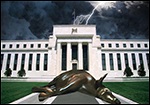by Pam Martens and Russ Martens, Wall St On Parade:

If you have been following the banking crisis, you have likely read at least a dozen times that on March 12 federal banking regulators, with the consent of the U.S. Treasury Secretary Janet Yellen, invoked the “systemic risk exception” in order to protect both insured and uninsured depositors at the two banks that failed in March – Silicon Valley Bank and Signature Bank.
TRUTH LIVES on at https://sgtreport.tv/
That’s why there were gasps of shock on Saturday evening at around 5:30 p.m. when the Wall Street Journal (paywall) published the stunning news that depositors in the Cayman Islands’ branch of Silicon Valley Bank had their deposits seized by the Federal Deposit Insurance Corporation (FDIC), which they are unlikely to ever see again.
As Wall Street On Parade has previously reported, under statute, the FDIC cannot insure deposits held on foreign soil by U.S. banks. What it can do, however, is to sell those deposits to the bank that acquires the collapsed bank. In the case of Silicon Valley Bank, the acquiring bank was First Citizens Bancshares which, apparently, declined to purchase the foreign deposits in the secrecy jurisdiction of the Cayman Islands, a jurisdiction most notable recently for the largest share of customers engaged with Sam Bankman-Fried’s crypto house of frauds.
The Journal reported that as of December 31, 2022, Silicon Valley Bank held $13.9 billion in foreign deposits with an unknown amount remaining as of the date of its failure and FDIC receivership on March 10. The Journal also reported that “On March 31, the FDIC notified SVB’s Cayman Islands depositors that they wouldn’t be covered by its deposit insurance, and that they would be treated as ‘general unsecured creditors,’ according to documents reviewed by the Journal as well as interviews with employees of multiple firms.”
Adding to what is certain to be political fallout, the depositors left out in the cold in the Cayman Islands branch included “investment firms in China and other parts of Asia.” Those depositors can’t be too happy to see their deposits seized while everyone else gets protected, whether they had deposit insurance or not.
What the Wall Street Journal has actually done with this report is to open a Pandora’s box regarding the vast sums of foreign deposits held in foreign branches of JPMorgan Chase and Citigroup’s Citibank – none of which are covered by FDIC insurance. It further raises the question as to why the banking regulators of these two Wall Street mega banks have allowed this dangerous situation to occur.
According to the year-end call report filed by Citibank, it held a stunning $622.6 billion of deposits in foreign offices. (See page 34 of call report.) According to the year-end call report filed by JPMorgan Chase Bank N.A., it held $426 billion in deposits in foreign offices. (See page 34 of the linked report.) Together, these two banks held just over $1 trillion in deposits on foreign soil – which had no U.S. deposit insurance backing.
As for whether the foreign jurisdiction’s deposit insurance scheme would apply to the foreign branch deposits of U.S. banks, the FDIC offers this two-sentence explanation in a recent report: “Deposits in foreign offices of U.S. banks are not insured by the FDIC. Some jurisdictions may provide some deposit insurance coverage of these deposits; the amounts of coverage, if any, vary by jurisdiction.”
In most cases, foreign countries’ deposit insurance schemes offer far lower deposit protection than the $250,000 per depositor, per bank, offered in the U.S.
JPMorgan Chase and Citibank also have exposure to uninsured domestic deposits – that is, deposits exceeding $250,000 per depositor in their bank branches on U.S. soil. At year end, JPMorgan Chase held $1.058 trillion in uninsured deposits in domestic branches while Citibank held $598.2 billion in uninsured deposits in domestic branches. Combining domestic and foreign uninsured deposits versus the $1.4 trillion Citibank held in total deposits at year end, means that 87 percent of Citibank’s deposit base lacked FDIC insurance protection. That is very close to the 90 percent of uninsured deposits held by Signature Bank when it blew up on March 12 and went into FDIC receivership.
Given Citibank’s history of teetering on the brink and being rescued by exorbitant sums from its financial “supervisors” during and after the financial crash of 2008, it is nothing short of an outrage to U.S. taxpayers that its banking regulators today have allowed 87 percent of its deposits to lack FDIC insurance protection. From December 2007 through mid 2010, Citigroup/Citibank received the following bailouts: the U.S. Treasury injected $45 billion of capital; there was a government guarantee of over $300 billion on certain of its assets; the FDIC provided a guarantee of $5.75 billion on its senior unsecured debt and $26 billion on its commercial paper and interbank deposits; and secret revolving loans from the Federal Reserve sluiced a cumulative $2.5 trillion in below-market-rate loans to Citigroup according to the eventual audit performed by the Government Accountability Office.
Read More @ WallStOnParade.com



